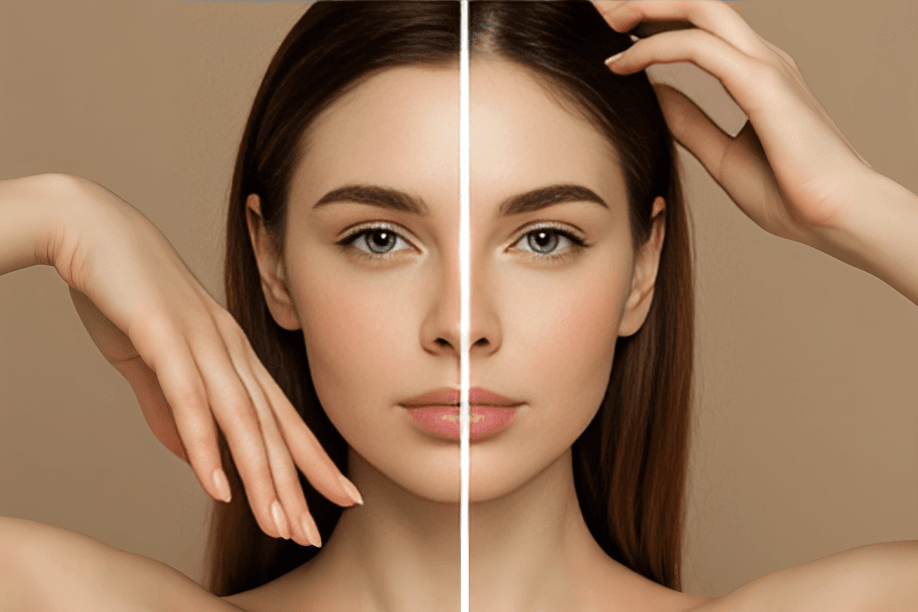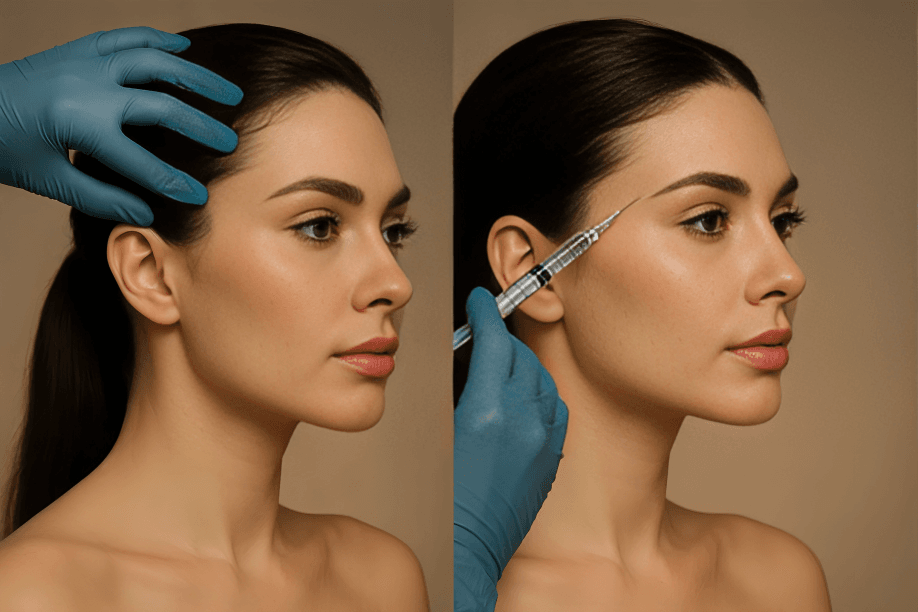
Calf Implants Explained: Procedure, Recovery, and Costs
Many people dream of sculpted, symmetrical legs that reflect balance, athleticism, and confidence. For some, however, genetics, injury, or muscle […]
The temples (also called the temporal area) are often the missing piece when it comes to achieving a truly refreshed, […]

The temples (also called the temporal area) are often the missing piece when it comes to achieving a truly refreshed, youthful upper face contour. Over time, the temples can exhibit temple volume loss, which not only results in hollowing but also affects the outer brow, eye frame and overall “upper face lift temple region” appearance. Non-surgical options like temple thread lift or temple filler have gained popularity—but for some patients, a temple lift surgery may still be the most effective solution. This article explores each option, clarifies “which is better temple lift vs fillers”, and helps you make an informed decision.
You can also explore specialists on Tabeebo to find a trusted clinician for your temple/temporal area rejuvenation.
The temporal region sits between the outer portion of the brow/eye area and the hairline, where fat pads, fascia and bone interact to provide structural support. With age (or weight loss), the temporal fat compartments diminish, soft-tissue support weakens, and the overlying skin may become lax. This contributes to:
A hollow or sunken appearance in the temple region.
Lateral brow descent (outer brow tail drops) and heavier upper eyelid appearance.
Loss of upper face balance—when the temples recede, the face can appear narrower and the eyes less open.
Restoring volume or repositioning tissues in the temporal region is key for achieving a natural temporal area rejuvenation and improving upper face harmony. New research confirms that volumising the temples can provide some “lifting” of the outer brow and eye area.
A temple lift surgery (sometimes called a lateral brow lift or temporal lift) uses a small incision at the hairline over the temple/temporal ridge. Through this access, the surgeon elevates and repositions the tissues (skin, fascia, sometimes orbicularis oculi muscle) and secures them to deeper fixation points. The result is a more elevated outer brow, smoother upper eyelid contour and improved temple region support.
Persons with moderate to advanced sagging of the outer brow/temple region.
Noticeable excess skin or drooping of the upper eyelid tail due to temple descent.
Good overall health and realistic expectations about a surgical procedure, recovery and scarring.
Seeking a long-lasting result rather than a temporary fix.
Strong lifting effect and repositioning of drooped tissues (not just volume addition).
Can provide a more lasting change in brow/temple position, improving upper face architecture.
When combined with eyelid surgery or full facelift, provides synergistic rejuvenation.
It is surgical: involves incisions, anesthesia, higher cost and longer downtime.
Potential risks: bleeding, infection, scarring (though typically hidden in hairline), nerve injury (though rare).
Results remain subject to aging—though you’re starting from a lifted baseline.
Requires careful selection of clinic and surgeon who understand the upper face and temple anatomy.
Recovery typically involves some swelling and modest downtime (often 1–3 weeks), and full aesthetic results may take a few months as tissues settle. Longevity can range several years depending on skin quality, lifestyle, and how aging proceeds.

A temple thread lift is a minimally invasive option in the spectrum between fillers and full surgery. Threads (often absorbable, barbed) are inserted under the skin in the temple/outer brow region to mechanically lift the tissues. The technique aims to reposition rather than voluminise. Some patients choose this as a “non-surgical temple lift” alternative to surgery.
Patients with mild to moderate outer brow descent and/or temple sagging, but decent skin elasticity.
Those who prefer less invasive procedures, minimal downtime, lower cost than surgery.
Patients willing to accept a shorter longevity effect and possible periodic maintenance.
Quicker procedure, fewer risks than surgery, less downtime.
Can provide a tangible lifting effect (not just filler volume).
May be an excellent “step up” from fillers before deciding on surgery.
The lift is generally more modest compared to surgery.
Results are less durable — often 1–2 years rather than multiple years.
Threads may feel or be visible in some patients (rare but possible).
As with all procedures, proper technique and anatomical knowledge are essential.
A temple filler involves injecting dermal fillers (commonly hyaluronic acid or biostimulants) into the temporal region to restore lost volume from the fat pads and skeletonisation. By restoring this “scaffold”, the outer brow and eye area can benefit from improved support and indirectly appear lifted. Many practitioners describe this as a non-surgical temple lift because of the subtle elevation effect.
Individuals whose main concern is temple volume loss (hollowing) rather than pronounced skin sagging.
Good skin quality with minimal drooping of the brow or eyelid.
Those seeking minimal downtime, lower cost, and non-surgical solutions.
Quick, less invasive, with minimal downtime. Often done in a clinic setting.
Helps “fill in” hollows, restore upper face balance, and provide an “eye lift” effect for the outer brow. Indeed, some research shows temple filler can lift eyes and brows by supporting lateral brow position. hubmeded.com+1
Adjustable and reversible (especially HA fillers) and good for “test” results before more permanent procedures.
The lift is mostly due to volume replacement—not a mechanical repositioning of tissue (so less “lift power” than surgery or threads).
Duration is temporary (typically 9–18 months, depending on product and patient). PubMed Central
Requires skilled injector due to the complex anatomy of the temple region (vessels, nerves) and risk of serious complications (e.g., vascular occlusion). PubMed Central+1
If skin laxity exists, filler alone may not correct the descent.

| Criterion | Temple Lift Surgery | Temple Thread Lift | Temple Filler |
|---|---|---|---|
| Invasiveness | High (surgical) | Moderate (minimally invasive) | Low (injectable) |
| Target Issue | Tissue sagging, brow descent | Mild-moderate sagging | Volume loss/hollowing |
| Lift vs Volume | Strong lift & repositioning | Moderate lift | Volume replacement with subtle lift |
| Downtime / Recovery | 1–3 weeks or more | Few days to up to a week | Minimal – same day activities often possible |
| Longevity | Longest (several years) | Intermediate (1–2 years) | Shortest (typically <2 years) |
| Cost | Highest | Middle | Lowest |
| Safety & Risk | Surgical risk (incisions, anesthesia) | Less risky but needs expertise | Low risk but serious complications if mis-placed |
| Best For | Sagging skin, outer brow droop | Moderate brow/temple descent | Temple hollowing, good skin tone |
Yes—but with important caveats. Many people wonder if “filler in temples to lift eyes/brows” is truly effective. According to a recent article:
“Filler in temples to lift eyes works by restoring structural support to the outer orbital rim and upper face. … By replacing lost volume and re-establishing tension in the lateral orbital area, temple filler provides mechanical lift to the brow tail.” hubmeded.com
Other sources are more cautious: one expert on RealSelf states that while temple filler is excellent for facial contours, “filling the hollowness in the temples will not provide any degree of lifting of the eyebrows” unless combined with other techniques. RealSelf.com
So what’s the balanced takeaway?
If the brow and eyelid heaviness are primarily due to volume loss (temple hollows), then temple filler can indeed help improve the eye-and brow region via structural support.
However, if the main problem is skin laxity or drooping of the brow/tail, filler alone may not be sufficient to truly “lift” the brow or open the eye. In that case, a temple lift surgery (or thread lift) may be more appropriate.
Identify your primary issue – Is it hollowness (volume loss) or sagging (tissue descent)?
Consult a qualified specialist – Use Tabeebo to find experts in the temple/temporal region (plastic surgeons, aesthetic dermatologists).
Ask the right questions:
How much temple volume loss do I have?
Is my brow tail sagging or just sunken?
What results can you realistically achieve with filler vs threads vs surgery?
What downtime, cost, and maintenance will I face?
What are the risks specific to the temple region (vessels, nerves)?
Consider timeline, budget and longevity – If you want a quick “boost” with minimal downtime, consider filler. If you’re seeking a long-term structural change and accept surgery, go for a temple lift. Threads may be an intermediate step.
Safety first – The temple region houses critical anatomy. Select a practitioner with deep knowledge of temporal anatomy and access to safe injection/lift techniques.
1: What’s the difference between temple hollowing and brow droop?
Temple hollowing means volume loss in the temple fat compartments, giving a sunken look. Brow droop refers to descent of the outer brow/eyelid region due to skin laxity or gravity. They may co-exist, but they call for different solutions.
2: Can fillers in the temples replace a surgical temple lift?
Not always. Fillers primarily restore volume and provide some lift via support; surgical temple lift repositions tissues and creates a mechanical lift. For significant sagging, surgery may be more effective.
3: How long does temple filler last?
Depending on the product and individual metabolism, temple fillers (e.g., hyaluronic acid) typically last around 9-18 months. Some studies show good results for over a year. PubMed Central
4: What is the downtime after temple lift surgery?
Most patients experience swelling and mild bruising for 1–2 weeks. Discomfort is moderate. Full settling may take several weeks. Your surgeon will give specific guidelines.
5: Are there risks with temple filler?
Yes. While minimal compared with surgery, there are serious risks if not performed correctly: filler migration, vascular occlusion, nerve injury (see case report of ophthalmoplegia after temple filler) PubMed Central+1
Always choose an experienced injector.
6: Can I combine treatments?
Absolutely. Many patients use filler to correct volume loss, threads for mild lift, and reserve surgery for more advanced cases. A combined approach can optimise results.
When considering upper face rejuvenation in the temple region, understanding the difference between volume loss and tissue sagging is key.
For hollow temples and good skin tone, a temple filler may provide a subtle yet meaningful improvement (non-surgical temple lift).
For moderate brow/temple descent and sagging skin, a temple thread lift offers a middle ground.
For more significant tissue descent and long-term results, a temple lift surgery remains the gold standard.
Be realistic about results, choose safety and expertise first—and your temple/temporal region can become a refreshed and supportive backdrop for your entire face.
Summary